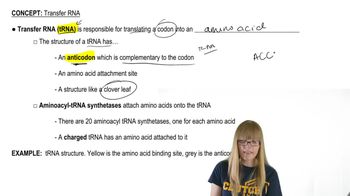In the triplet binding technique, radioactivity remains on the filter when the amino acid corresponding to the codon is labeled. Explain the rationale for this technique.
Table of contents
- 1. Introduction to Genetics51m
- 2. Mendel's Laws of Inheritance3h 37m
- 3. Extensions to Mendelian Inheritance2h 41m
- 4. Genetic Mapping and Linkage2h 28m
- 5. Genetics of Bacteria and Viruses1h 21m
- 6. Chromosomal Variation1h 48m
- 7. DNA and Chromosome Structure56m
- 8. DNA Replication1h 10m
- 9. Mitosis and Meiosis1h 34m
- 10. Transcription1h 0m
- 11. Translation58m
- 12. Gene Regulation in Prokaryotes1h 19m
- 13. Gene Regulation in Eukaryotes44m
- 14. Genetic Control of Development44m
- 15. Genomes and Genomics1h 50m
- 16. Transposable Elements47m
- 17. Mutation, Repair, and Recombination1h 6m
- 18. Molecular Genetic Tools19m
- 19. Cancer Genetics29m
- 20. Quantitative Genetics1h 26m
- 21. Population Genetics50m
- 22. Evolutionary Genetics29m
11. Translation
The Genetic Code
Problem 13d
Textbook Question
Third-base wobble allows some tRNAs to recognize more than one mRNA codon. Based on this chapter's discussion of wobble, what is the minimal number of tRNA molecules necessary to recognize the following amino acids?
Lysine
 Verified step by step guidance
Verified step by step guidance1
Understand the concept of wobble: The wobble hypothesis explains that the third base of a codon (on mRNA) and the first base of the anticodon (on tRNA) can form non-standard base pairing, allowing a single tRNA to recognize multiple codons.
Identify the codons for lysine: Lysine is encoded by two codons, AAA and AAG, according to the genetic code.
Determine the wobble base pairing rules: The third position of the codon (wobble position) allows for flexibility in pairing. For example, the anticodon base 'U' can pair with both 'A' and 'G' in the wobble position.
Analyze the anticodon requirements: A single tRNA with an anticodon complementary to UUU (which pairs with AAA and AAG) can recognize both codons for lysine due to wobble pairing.
Conclude the minimal number of tRNAs: Based on the wobble hypothesis, only one tRNA molecule is necessary to recognize both codons for lysine.
 Verified video answer for a similar problem:
Verified video answer for a similar problem:This video solution was recommended by our tutors as helpful for the problem above
Video duration:
2mPlay a video:
Was this helpful?
Key Concepts
Here are the essential concepts you must grasp in order to answer the question correctly.
Wobble Hypothesis
The wobble hypothesis explains how the third position of a codon can tolerate mismatches between the codon in mRNA and the corresponding anticodon in tRNA. This flexibility allows a single tRNA to pair with multiple codons that code for the same amino acid, thereby reducing the total number of tRNA molecules required for protein synthesis.
Recommended video:
Guided course

Translation:Wobble Hypothesis
tRNA and Codons
Transfer RNA (tRNA) molecules are responsible for bringing amino acids to the ribosome during protein synthesis. Each tRNA has an anticodon that pairs with a specific codon on the mRNA. Understanding the relationship between tRNA and codons is crucial for determining how many tRNA molecules are needed to recognize all codons for a particular amino acid.
Recommended video:
Amino Acid Codons
Amino acids are encoded by specific sequences of three nucleotides known as codons. For lysine, there are two codons: AAA and AAG. Recognizing that multiple codons can correspond to the same amino acid is essential for calculating the minimal number of tRNA molecules required to translate the genetic code accurately.
Recommended video:
Related Videos
Related Practice
Textbook Question
413
views



